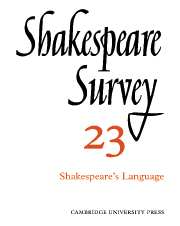Book contents
- Frontmatter
- Shakespeare and the Tune of the Time
- Some Functions of Shakespearian Word-formation
- Guide-lines for Interpreting the Uses of the Suffix ‘-ed’ in Shakespeare’s English
- Shakespeare’s Use of Colloquial Language
- Words, Action, and Artistic Economy
- ‘Antony and Cleopatra’: the Limits of Mythology
- Shakespeare’s ‘War with Time’: the Sonnets and ‘Richard II’
- Shakespeare and Christian Doctrine: Some Qualifications
- Shakespeare’s Poets
- The Text of Coleridge’s 1811–12 Shakespeare Lectures
- Shakespeare Studies in German: 1959–68
- A Neglected Jones/Webb Theatre Project: ‘Barber-Surgeons’ Hall Writ Large
- Interpretation or Experience? Shakespeare at Stratford
- 1 Critical Studies
- 2 Shakespeare’s Life, Times, and Stage
- 3 Textual Studies
- Index
- Plate section
2 - Shakespeare’s Life, Times, and Stage
Published online by Cambridge University Press: 28 March 2007
- Frontmatter
- Shakespeare and the Tune of the Time
- Some Functions of Shakespearian Word-formation
- Guide-lines for Interpreting the Uses of the Suffix ‘-ed’ in Shakespeare’s English
- Shakespeare’s Use of Colloquial Language
- Words, Action, and Artistic Economy
- ‘Antony and Cleopatra’: the Limits of Mythology
- Shakespeare’s ‘War with Time’: the Sonnets and ‘Richard II’
- Shakespeare and Christian Doctrine: Some Qualifications
- Shakespeare’s Poets
- The Text of Coleridge’s 1811–12 Shakespeare Lectures
- Shakespeare Studies in German: 1959–68
- A Neglected Jones/Webb Theatre Project: ‘Barber-Surgeons’ Hall Writ Large
- Interpretation or Experience? Shakespeare at Stratford
- 1 Critical Studies
- 2 Shakespeare’s Life, Times, and Stage
- 3 Textual Studies
- Index
- Plate section
Summary
The question of Shakespeare’s identity, always so rewarding for the imaginative writer, has provided the year’s most entertaining item among many delightful contributions to the study of the dramatist’s life—William Honey’s The Shakespeare Epitaph Deciphered. Mr Honey’s beginning was, he tells us, with Shakespeare’s end, more precisely, with the bard’s doggerel epitaph which, he discovered, was capable of being deciphered as follows (spelling has been modernized):
Good friend who wishes for Shakespeare
To dig the dust: entombed here:
Plays by the man, verses his sonnets
And Christopher Marlowe's bones.
From this starting point, we are told, the author proceeded to ‘bolster up’ his discovery with historical facts. These include the murder of the actor William Shakespeare, Marlowe’s impersonation of him, and his subsequent acceptance by Shakespeare’s degenerate family (including Anne Hathaway) and (more puzzlingly) his associates. The reviewer was charmed but unconvinced. Delight has also been afforded by another imaginative work of a very different kind, Ivor Brown’s The Women in Shakespeare’s Life. Taking the scraps of information available to us about Shakespeare’s mother, wife and daughters as his point of departure, the author has woven round them his considerable knowledge of the period with characteristic charm, creating a graceful ‘family portrait’ which cannot fail to enchant its anticipated audience of ‘Avonside tourists . . . under the influence’. Taking the scraps of information available to us about Shakespeare's mother, wife and daughters as his point of departure, the author has woven round them his considerable knowledge of the period with characteristic charm, creating a graceful 'family portrait' which cannot fail to enchant its anticipated audience of 'Avonside tourists . . . under the influence'.
- Type
- Chapter
- Information
- Shakespeare Survey , pp. 159 - 176Publisher: Cambridge University PressPrint publication year: 1970

